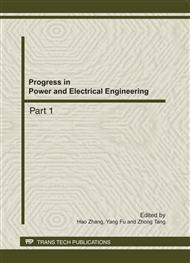p.835
p.842
p.847
p.853
p.859
p.866
p.872
p.877
p.881
The Power Quality Analysis and its Enhancement Scheme in Power Distribution of an Automobile Factory
Abstract:
Nonlinear loads are widely spread in automobile industry along with the development of power electronic technology, which causes proliferation of power quality problems, such as harmonics, voltage fluctuation, etc. The problems result in detrimental effects to the power distribution systems, increasing power loss in the network and affecting the safety operation of electrical appliances. This paper analyzed the power quality problems and proposed an enhancement scheme implemented in an automobile factory. The scheme has already got an application in one of the transformer substations. It’s revealed that the proposed scheme can improve significantly the power factor of the 400V bus in car body workshop, and the harmonics injection to the utility grid can be within the limit of related standard.
Info:
Periodical:
Pages:
859-865
Citation:
Online since:
October 2011
Authors:
Price:
Сopyright:
© 2012 Trans Tech Publications Ltd. All Rights Reserved
Share:
Citation:


